
Review: Cubase 13
With its latest version, Cubase proves itself to be back in the game.
Almost two years ago I reviewed Cubase 12, but comparing any new release to previous incarnations isn’t so helpful because, really, die-hard users of any DAW are kind of tribal and don’t need anyone like me to analyse whether or not to upgrade to a latest version. Some folks will update as a matter of course immediately anyway, while others will slice through the internet cable to avoid any inadvertent download until a few bug-fixing patches have been released. Functions will always be added and removed, and the Steinberg forums will undoubtedly rumble with brickbats and bouquets for months – whatever the hell is a “brickbat”. Let’s leave ‘em to it.
Instead, how does Cubase 13 shape up as a first-up choice? What if you’re relatively new to the world of digital recording, or you’ve been disenchanted with your current DAW and you’re looking to make a switch. Both can involve a decades-long commitment to the software, and it’s a decision not to be made lightly.
ONE STEP AT A TIME
Having said the above, we do have to reference the previous release, Cubase 12, to some degree. In many areas it was a major revamp of the DAW, and this latest version is an important step in continuing that process, and it’s notable that Cubase 13 has come along without any half-steps of versions like ‘12.5’ in the meantime. That’s a good thing. Steinberg didn’t succumb to any pressures to push out an interim version to satisfy an impatient user-base. So, what’s significantly new in Cubase 13?
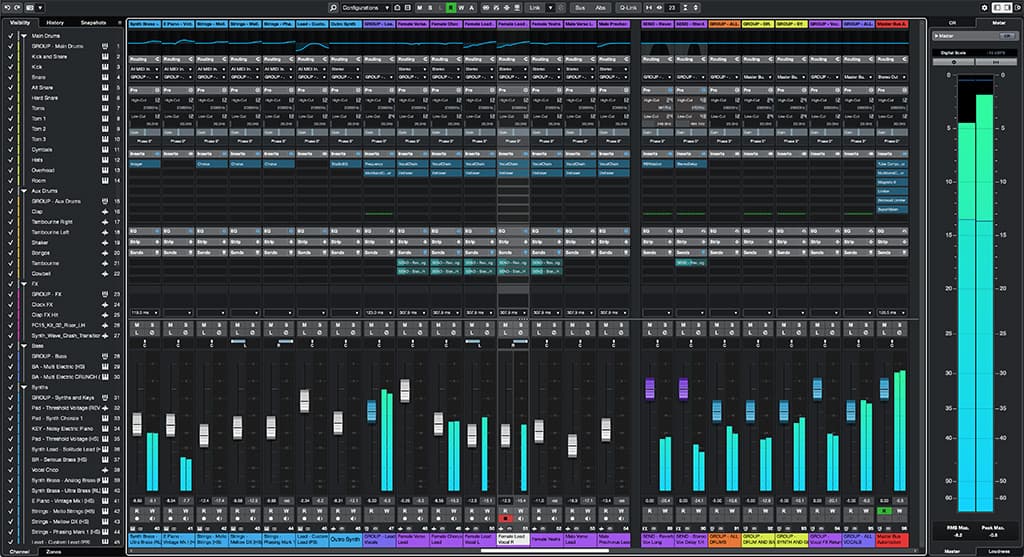
This is the full console with metering added on the right. On the left is the Visibility function. You can hide channels that don’t interest you anymore. Harmonica comes to mind.
MIXING IT UP
The MixConsole is Cubase’s moniker for the mixer window. It’s been given another make-over to appear a lot cleaner and clearer, and some interesting workflow changes have been made. Essentially, one click on any plug-in or parameter will expand into a GUI of that device. You can make your tweaks, and one click away will collapse the window. That’s a big deal? Actually it is, because you can get a little frustrated hovering your mouse over a virtual mixer trying to slide regions larger or smaller, or scrolling through lists before opening a plug-in, then closing it afterwards, especially on high resolution monitors. This improvement is a simple but very effective workflow enhancement that’ll reduce about, oh, a zillion mouse-clicks from every session.
You can also quickly change or reset what’s visible in the MixConsole in the Set Up Window dialogue box. For example, if you’ve recorded all your tracks and VSTs, and something like routing is no longer a priority, you can deselect that box and the routing slot disappears. Maybe you prefer a third-party EQ or want to put the new VocalChain on every channel instead (more on that later). Again, deselecting the EQ box removes that slot from the MixConsole – importantly, this doesn’t deactivate the modules but only hides them. If you are using the EQ on a channel, it’ll still work in the background. The idea is to unclutter the mixer so you can focus on the plug-ins and parameters important to you. This is a much quicker way to customise the workspace rather than fiddling around with creating Window Layouts and swapping between those.
Overall, with each release Cubase has been edging away from the utilitarian, icon-driven appearance of the past and catering more towards emulating a physical, digital console – even if we are all running those through a tablet app anyway. The Cubase 13 MixConsole GUI is intuitive to use with enough familiar analogue-like aspects to satisfy engineers who’ll probably slip outside for a fag and a Coke every ten minutes.
NEED TO KNOW
Cubase 13
Digital Audio Workstation
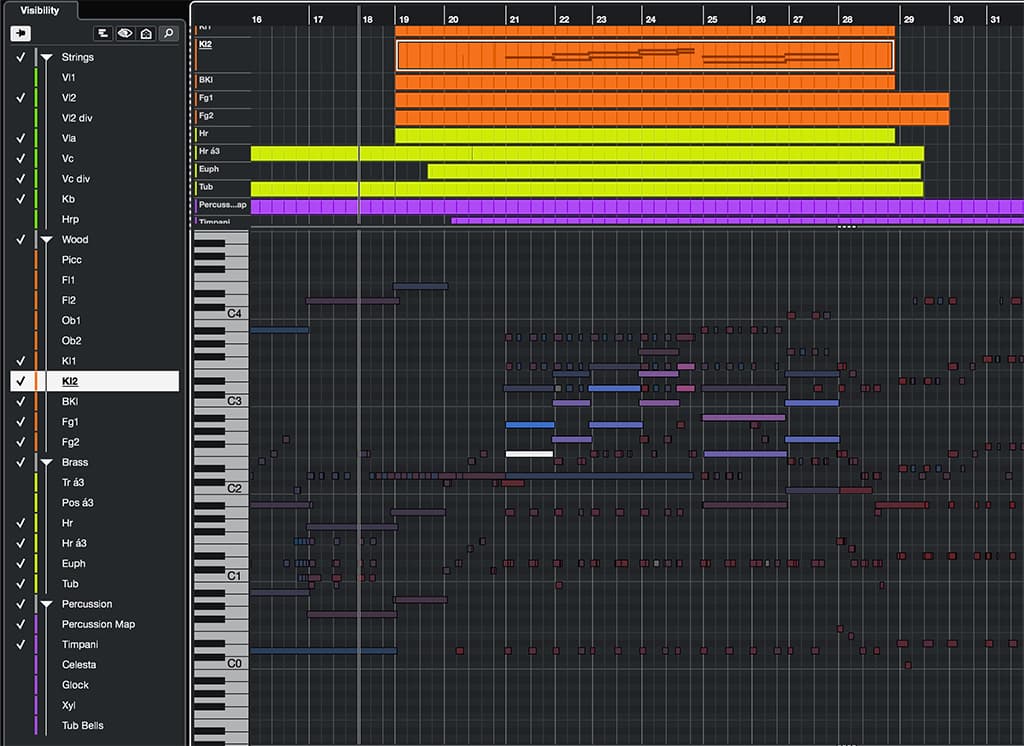
Here all your MIDI tracks are displayed (or not) in a single window. It takes a bit of fiddling to separate tracks according to colour – for example – then the ability to make global edits across all your tracks will save heaps of time.
THE MASTER OF MIDI
The impressive lineage of Cubase means it’s been working with MIDI for a very long time, and the MIDI capability is comprehensive to say the least. Steinberg is constantly refining the MIDI functions and editing workflows available including removing those deemed obsolete (that’s always bound to upset someone). Cubase 13 introduces a Range Tool which is a bit overdue to be honest, plus Multi-Part Editing – now that’s interesting. Remember, we’re talking MIDI here. If you have, say, 20 MIDI tracks in an arrangement, all the MIDI data and notes can be displayed in a single editing window with each individual track separated out using a Visibility tab. For instance, if part of the entire arrangement needs a chord change, rather than having to switch laboriously through all of those 20 tracks and editing each one, every track can be displayed in the one editing space. The ability to apply sort of global edits to your MIDI programming in a single window is a huge time-saver.
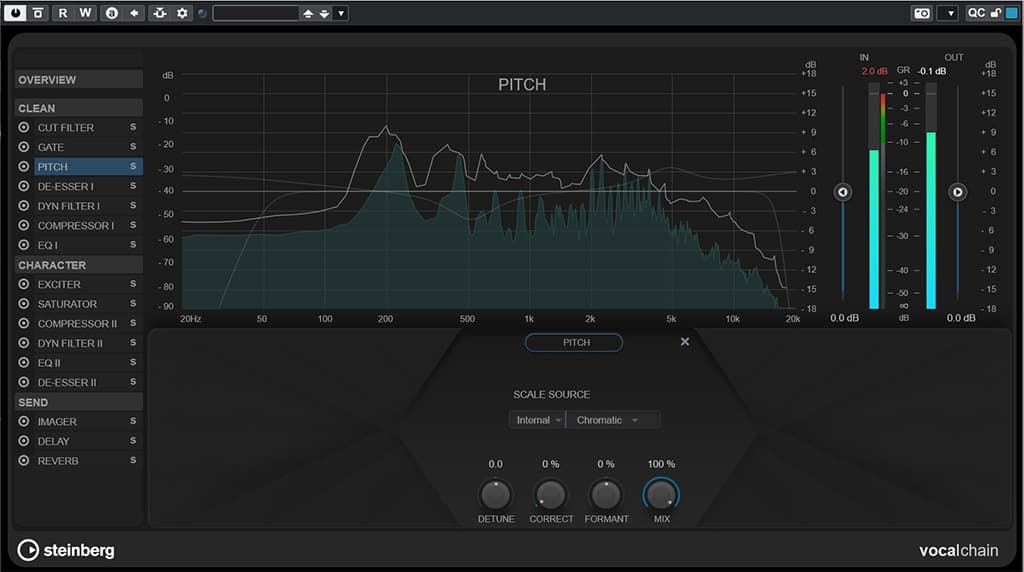
With all the tools available in VocalChain, if you can’t pull a decent vocal sound…
THE NEW GOODIES
Every DAW release includes some new plug-ins and processors to tempt the long-time users into upgrading. Cubase 13 has a doozy called VocalChain. It integrates every possible vocal processing into one plug-in, sometimes with multiple instances such as two compressors, two EQs and two De-Essers. There’s compression, of course, and ‘Character’ processing in an Exciter and Saturator, and Delay and Reverb effects. A reasonable Pitch Correction tool will fix most vocal fluffs, or you can use it as an effect like everyone else in the last 20 years. With all the different permutations in each section of VocalChain, plus being able to reorder each one, you have an endless number of results, and there’s no need to restrict to just vocals. It’s a powerful tool and you could just about forget all the other plug-ins altogether and chuck VocalChain on every channel.
They are a two new Pultec-style EQs, the EQ-P1A and EQ-M5, and a standalone compressor called the Black Valve. These plug-ins are all about imparting a particular colour to the sound that’s associated with the vintage gear rather than offering signal processing that isn’t already well-catered for in other plug-ins.
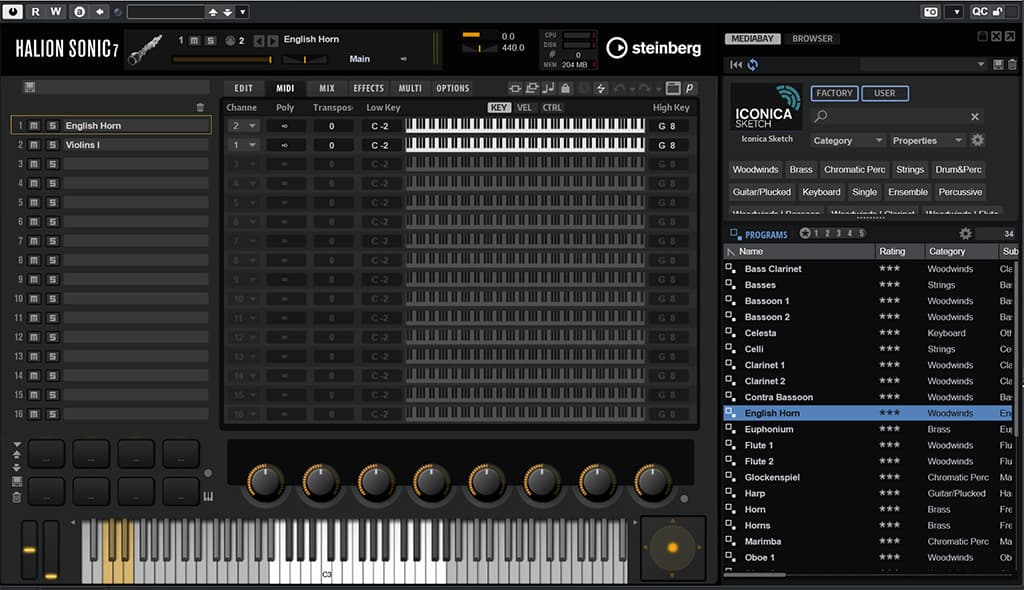
Hosted by HALion Sonic 7 you get 16 channels of orchestration and a choice of 34 instruments. Not for the faint-hearted, really.
ICONICA SKETCH
The newly included Iconica Sketch is a cut-down version of the full-blow Iconica VST, a HALion orchestral instrument that has a monster library of samples all dedicated towards symphonic composition. Iconica Sketch is no slouch despite having a much smaller library and allows for 16 tracks of orchestration using the usual suspects of strings, brass, woodwind … you know the, ah, score. If you watch any demo videos, the Steinberg guru rattles out a quick Beethoven’s Ninth without his fingers ever leaving his hands and sounds super-impressive. The reality is that Iconica Sketch is very capable indeed, but you need to know what you’re doing musically with an orchestra to get those sorts of results. This isn’t a VST instrument for beginners to create film scores with one finger. Having said that, just working with Iconica Sketch doubles as an easy lesson in notation and theory. You’ll learn some basics without even trying.
CATCHING UP
Some of the new features in Cubase 13 aren’t so ground-breaking, offering what other DAWs have had for a while. Maybe that’s what forum New Feature Requests do for you – “Why can’t Cubase do such-and-such? REAPER does it!!!” Forum folks can be quite uppity.
The Channel Tab displays for any selected track in the Arrange View the corresponding Mixer fader and inserts, etc., in a breakaway panel. This avoids having to swap between the Arrange and MixConsole views if you want to quickly tweak something in the latter.
Every track/channel in your arrangement can now be switched between mono and stereo via a single icon. While you might think that’s a choice made first, some VSTs like Native Instrument’s Guitar Rig have stereo effects that won’t happen unless the track is stereo, even though the input is a mono guitar. You’ve just recorded the perfect, shredding solo, but dang! You need that stereo patch effect… that’s easy fixed now.
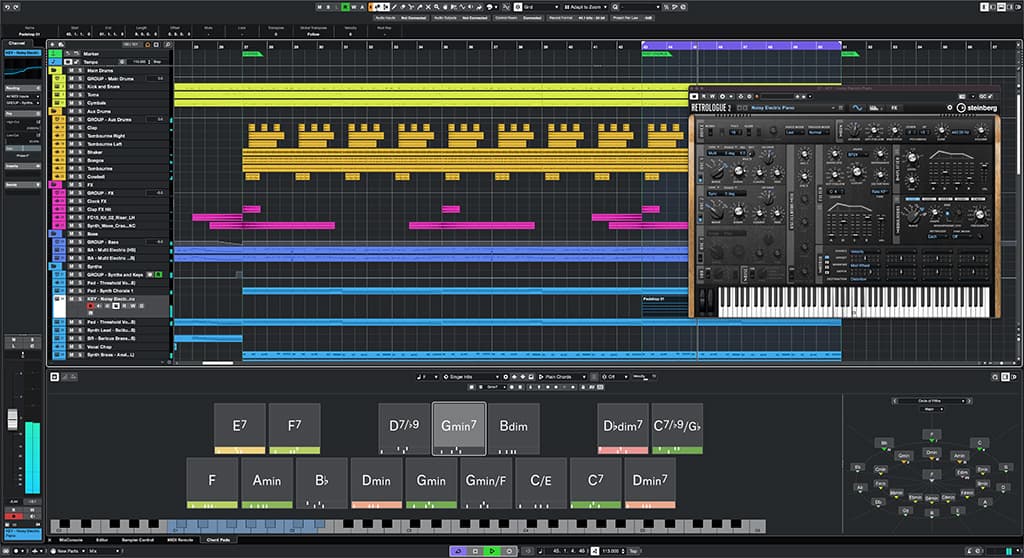
You can see how each Chord Pad is clearly labelled – however, note the colour-coding between the chords and the Circle of Fifths on the right showing how well your chords suit the key signature. Why bother learning this music theory stuff?
The improved Chord Pad lets you assign any chord you like to the individual virtual pads, then you can trigger that pad however you like. This lets fumbling keyboard players like me cheat and play a DmAug7th# plus an F# bass with a single finger (for the musically inclined, I have no idea if that chord is even a thing). There are ways and means to humanise that programming later. As an added incentive to not learn piano properly, it displays a Circle of Fifths and suggests chords that suit your composition.
AND THE OLD FAITHFULS
To repeat what I’ve mentioned in earlier reviews, Cubase has for a while been a complete DAW providing everything you need to create music for today’s market – this is after Cubase falling somewhat behind the pack about a decade ago. A bunch of included VSTis – which have been part of the Pro bundle for years – give you retro synths, grand pianos, a sampler… and the basic HALion Sonic synth has a decent-size library with every instrument you can think of – in particular a usable drum library. Likewise, the standard plug-ins leave nothing lacking.
Even so, Cubase 13 has managed to add more by bringing in Iconica Sketch, and the VocalChain is almost a deal-maker on its own.
Cubase 13 is not just an important step, but a solid step forward for the DAW for existing users, and a wise choice for newcomers – although don’t forget that with all these functions and features comes a reasonable learning curve. As always, Cubase 13 is available in various versions and if you’re impressed by any of the features I’ve covered here, check on the Steinberg website what you do and don’t get.
Or just go for the full Cubase Pro and you’ll have everything you need for years to come.





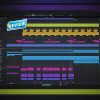

















RESPONSES